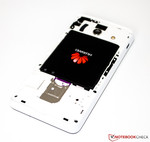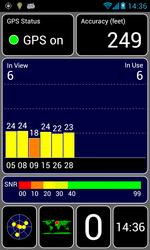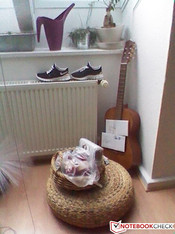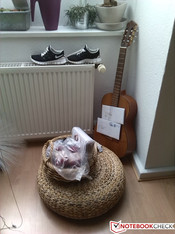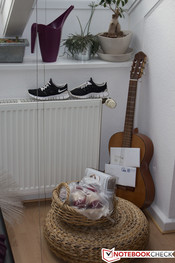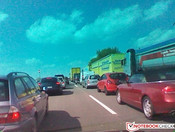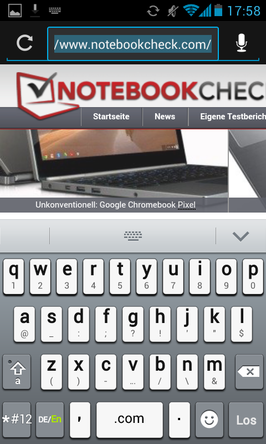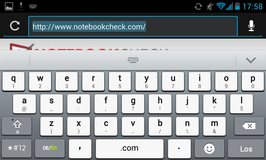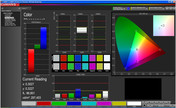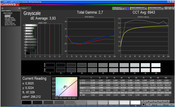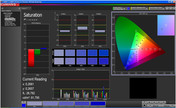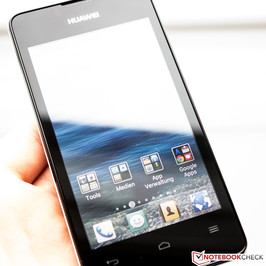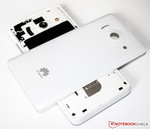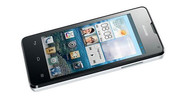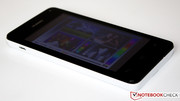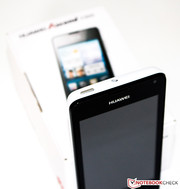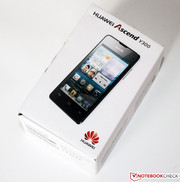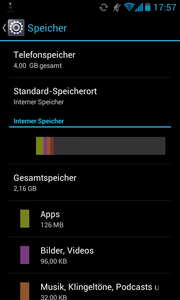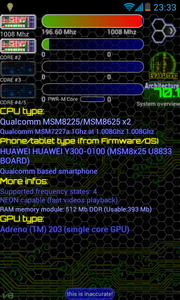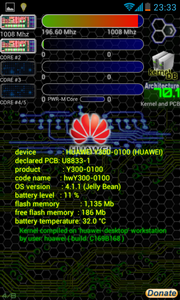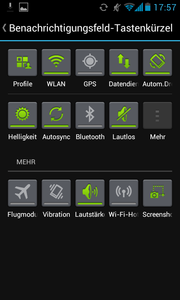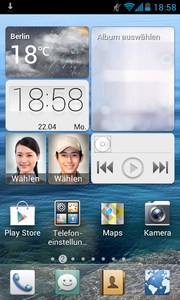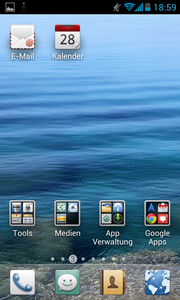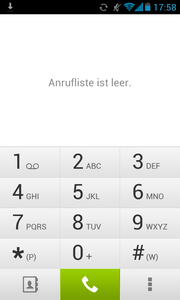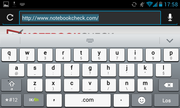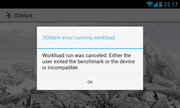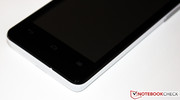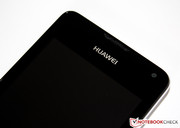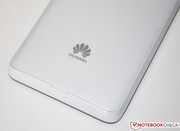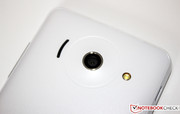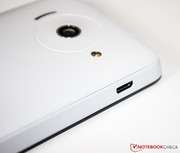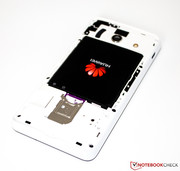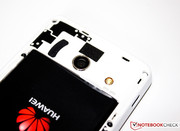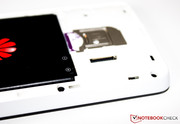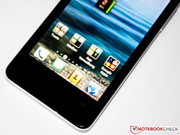Review Huawei Ascend Y300 Smartphone

For the original German review, see here.
Huawei sets new standards with the Ascend Y300. We already reviewed the pretty inexpensive Ascend G600 for 300 Euros (~$391) but the company managed to cut this price in half for the smallest model Y300: For only 149 Euros (~$194) you can own a 4-inch smartphone. Obviously this price is realized with lower performing hardware; the clock of the Qualcomm Snapdragon S4 MSM8225, for instance, was lowered to 1 GHz and is only supported by 512 MB RAM. However, the GPU is identical to the G600 (Adreno 203) and the display resolution is still up to date. With 800x480 pixels it has the same resolution as the HTC One SV, which is 0.3 inches larger. So how does Huawei manage to offer a device for such a price and what are the drawbacks?
Case
The first impression is not overwhelming; the back is made of white plastic. We do not want to call it cheap but this adjective certainly crossed our mind. The material of the battery cover is very thin and it is constantly moving, at least on our review unit. Due to different gaps the cover does not fit properly. At least the polycarbonate is matte and does not attract fingerprints. Twisting the device resulted in loud creaking noises everywhere; in addition the display could be slightly pushed in at the center. Compared to the Sony Xperia J the device is bigger in every dimension with 124.5 x 63.8 x 11.2 mm (Xperia J: 124.3 x 61.2 x 9.2 mm). As a result the device is also slightly heavier (130 grams). The entry-level smartphone is currently available in black and white.
Connectivity
With such a retail price you certainly should not expect any innovations. However, it is nice that the device has a removable battery and that the storage is expandable via micro SD slot. Certainly a must-have feature since the capacity of the internal storage is very limited with only 4 GB. At the right side of the case we can only find the volume rocker. At the top we have the 3.5 mm stereo jack (center) and the power button next to it on the left. The micro USB slot is located at the left side and can be used to recharge the smartphone and establish a connection to a computer. After the removal of the battery cover you have access to the micro SD slot and the SIM card.
Software
Android 4.1 (Jelly Bean) is the operating system. In addition Huawei also integrated its own launcher EmUI (Version 1.0). At first it seems very Android-like but at a closer look we see that the App-Drawer has been removed. This means that all apps are present on the home screens. You can create folders but a certain chaos cannot be avoided - not a perfect solution. We cannot find any noticeable adjustments in the system settings; there should not be any problems even for Huawei beginners.
Communication & GPS
When it comes to the communication modules the Y300 tries to keep up with its big competition; almost every known module is integrated. However, if we have a closer look at the standards we can see that some of them are not up to date. Bluetooth, for instance, is only available in version 2.1+EDR, the latest version is 4.0. The receiving and transmitting modules for mobile internet are not the fastest either. HSDPA provides download rates of up to 7.2 Mbit/s. We have to admit this is criticism on a very high level; a downstream of 7.2 Mbit/s delivers, if available, very good performance. The WLAN module supports the 802.11 b/g/n standards and works reliably and without sudden connection losses. The Y300 is equipped with DLNA to stream media content via your home network. An aGPS module is also integrated; we could establish a connection near a window but the result was not very accurate, the performance was better outdoors.
Telephone
There are not many settings and we cannot determine any changes. The telephone menu has not really been changed or adjusted; nobody should have a problem making a call.
Cameras & Multimedia
The Y300 has two cameras; the main camera is at the back. It takes pictures with 5 megapixels and is supported by an autofocus and an LED flash. The front camera works with just 0.3 MP; its main purpose is a webcam for video calls.
Indoors the results of the main camera are surprisingly good. Despite the average brightness we cannot determine significant picture noise and the details are sharp. The front camera shows a significant red cast and should only be used for video calls. Outdoors and with sufficient brightness the main camera convinces with a very sharp picture but we can determine a slight blue cast. The sky, for instance, appears more colorful than the reality. Nevertheless, it is a very respectable result for a 150 Euros (~$195) smartphone. On the other hand the pictures of the front camera are catastrophic, colors are heavily deviated and you can almost count every single pixel.
Warranty & Accessories
The warranty period of the Y300 is 12 months; the battery only comes with a 6-month warranty. Similar to the warranty the scope of delivery is also very limited; the box only contains a modular power supply unit.
Input Devices & Handling
The touchscreen reacts very precisely and also executes the inputs - but there are delays in some situations. We can clearly see the performance impact by the low price. You should not expect instant reactions from the 1 GHz processor and the limited memory. Switching between home screens also results in delays - sometimes more, sometimes less.
Display
Unfortunately the 4-inch LCD-TFT-Display is not based on IPS technology but offers a reasonable resolution of 800x480 pixels and good results in our tests instead. Actually we were surprised by the determined values. The average brightness of 289.8 cd/m² is about 30 cd/m² brighter than the display of the G600; the brightness distribution of 92% is also on a very high level. Similar priced devices and even mainstream devices certainly have problems to keep up with these results. The Ascend G600, which is twice as expensive, just reaches 85% and even the Xperia J or the HTC One SV "just" get 90%.
| |||||||||||||||||||||||||
Brightness Distribution: 92 %
Center on Battery: 300 cd/m²
Contrast: 667:1 (Black: 0.45 cd/m²)
The black value of 0.45 cd/m² is very high for this price class and even slightly better compared to the One SV (0.49 cd/m²). The resulting contrast is 667:1; subjectively the display lacks a certain sharpness. Due to the technology the colors are a bit pale but more natural than an AMOLED-display, for example. With the CalMAN 5 software and our colorimeter we check our impressions. The display shows a slight blue cast and the red colors are too weak. The DeltaE value for blue is clearly above 5; the grayscale presentation deviates from the norm with every brightness setting.
Contrast and maximum brightness are good for a device in this price range, yet not sufficient to work well under direct sunlight. The glossy display is another problem; you have to adjust the angle of the device and avoid direct sunlight to see the display content.
Viewing angles are not really a strong suit of the Y300. The display immediately loses brightness and contrast when the viewing angles get smaller. Colors deviate and the visibility is not very good.
Performance
We are already familiar with the Qualcomm Snapdragon S4 MSM8225; the Huawei Ascend G600 was equipped with a higher clocked version. We are not sure why Huawei decided to reduce the clock. Of course this leads to better battery runtimes but at the same time it has a negative impact on the performance. The limited memory of 512 MB reduces the performance even more. The flash storage with its 4 GB is not up to date, some of the latest 3D games occupy between 300 and 500 MB alone. Huawei integrated a micro SD slot to avoid this bottleneck.
We do not expect too much from the Y300 in the benchmarks - but maybe the entry-level device can surprise us?
We ran numerous synthetic benchmarks and sometimes we were really surprised. Even before we could complete our tests and fill our database with the results some benchmarks really stood out - unfortunately not due to the performance. We could not run GLBenchmark 2.5; the application kept shutting down. Numerous reboots did not solve the problem and we had the same issues with the latest 3DMark - Ice Storm Standard and Linpack. In the other benchmarks the Y300 gets better results than the Xperia J, not bad if we consider the similar clock and the limited RAM. Although the hardware of the G600 should be faster both devices are actually neck and neck. The hardware of the HTC One SV is way faster and we also list the HTC One to show the performance of the latest high-end hardware.
| AnTuTu v3 - Total Score (sort by value) | |
| Huawei Ascend Y300 | |
| Huawei Ascend G600 | |
| Sony Xperia J | |
| HTC One SV | |
| HTC One | |
| AnTuTu 3DRating - --- (sort by value) | |
| Huawei Ascend Y300 | |
| Huawei Ascend G600 | |
| Sony Xperia J | |
| HTC One SV | |
| HTC One | |
| NenaMark2 - --- (sort by value) | |
| Huawei Ascend Y300 | |
| Huawei Ascend G600 | |
| Sony Xperia J | |
| HTC One SV | |
| HTC One | |
| Geekbench 2 - 32 Bit - Total Score (sort by value) | |
| Huawei Ascend Y300 | |
| Huawei Ascend G600 | |
| Sony Xperia J | |
| HTC One SV | |
| HTC One | |
| Smartbench 2012 | |
| Productivity Index (sort by value) | |
| Huawei Ascend Y300 | |
| Huawei Ascend G600 | |
| Sony Xperia J | |
| HTC One SV | |
| HTC One | |
| Gaming Index (sort by value) | |
| Huawei Ascend Y300 | |
| Huawei Ascend G600 | |
| Sony Xperia J | |
| HTC One SV | |
| HTC One | |
The results of the browser based benchmarks are not overwhelming. The performance of our review unit is similar to the Sony Xperia J. Both devices are always at the bottom of our rankings. We used the preinstalled Android browser for the benchmarks.
| Google V8 Ver. 7 - Google V8 Ver. 7 Score (sort by value) | |
| Huawei Ascend Y300 | |
| Huawei Ascend G600 | |
| Sony Xperia J | |
| HTC One SV | |
| HTC One | |
| Browsermark - --- (sort by value) | |
| Huawei Ascend Y300 | |
| Huawei Ascend G600 | |
| Sony Xperia J | |
| HTC One SV | |
| HTC One | |
| Peacekeeper - --- (sort by value) | |
| Huawei Ascend Y300 | |
| Huawei Ascend G600 | |
| Sony Xperia J | |
| HTC One SV | |
| HTC One | |
| Sunspider - 0.9.1 Total Score (sort by value) | |
| Huawei Ascend Y300 | |
| Huawei Ascend G600 | |
| Sony Xperia J | |
| HTC One SV | |
| HTC One | |
* ... smaller is better
We use AndroBench to determine the read and write performance of the integrated flash storage. The storage shows weaknesses in every single discipline. Even with simple sequential reads the Y300 falls behind the competition by almost 150%. This bad result will most likely also have a negative impact on multimedia applications.
| AndroBench 3-5 | |
| Random Write 4KB (sort by value) | |
| Huawei Ascend Y300 | |
| Huawei Ascend G600 | |
| Sony Xperia J | |
| HTC One SV | |
| HTC One | |
| Random Read 4KB (sort by value) | |
| Huawei Ascend Y300 | |
| Huawei Ascend G600 | |
| Sony Xperia J | |
| HTC One SV | |
| HTC One | |
| Sequential Write 256KB (sort by value) | |
| Huawei Ascend Y300 | |
| Huawei Ascend G600 | |
| Sony Xperia J | |
| HTC One SV | |
| HTC One | |
| Sequential Read 256KB (sort by value) | |
| Huawei Ascend Y300 | |
| Huawei Ascend G600 | |
| Sony Xperia J | |
| HTC One SV | |
| HTC One | |
Videos & Games
We determine the multimedia capabilities of devices with several video sequences. In the case of our review unit we start light with the playback of an HD trailer (720p) and to our surprise the Android-Player starts the playback. Unfortunately, we see heavy stutters and lags. Normally we could skip the Full HD (1080p) movie but we tried anyway - result: Does not work at all. The standard player cannot show the movie; we have to use additional software from the Play Store. But even then the playback is not smooth.
The 3D gaming performance is similar to the video performance. GTA III or Need for Speed can be played but the experience is not very smooth and therefore not very enjoyable. However, the less demanding 3D game The Room runs smoothly. Familiar games like Cut the Rope, Fruit Ninja or Angry Birds are no problem for the Y300.
The voice quality is average. We could understand the other person very well and the volume was sufficient. We did not determine any background noises during our test calls but you should avoid the built-in hands-free feature; the sound quality is not very good.
Emissions
Temperature
Compared to the Ascend G600 the Y300 gets slightly warmer. Despite the larger case and the lower clock the temperatures of the G600 cannot be replicated. The average load temperatures of our review unit are between 32.7 and 35.3 °C; these values drop to 27.9 and 28.8 °C during idle. The smartphone is not very warm or even hot in both scenarios. The same applies for the PSU; we determine a temperature of 40.4 °C, which is not in the critical area.
(+) The maximum temperature on the upper side is 38.4 °C / 101 F, compared to the average of 35.2 °C / 95 F, ranging from 21.9 to 247 °C for the class Smartphone.
(+) The bottom heats up to a maximum of 36.7 °C / 98 F, compared to the average of 34 °C / 93 F
(+) In idle usage, the average temperature for the upper side is 28.8 °C / 84 F, compared to the device average of 32.9 °C / 91 F.
Speaker
The mono speaker is located at the back next to the main camera lens. We already mentioned the bad performance of the hands free function so we do not expect any wonders in this section. The sound is very tinny and almost exclusively consists of high tones. We cannot determine any volume raise above 60% - but this is a positive aspect, at least for our ears. The speaker is covered when we put the device on a flat surface and the resulting sound is slightly distorted. We are actually not sure whether the sound is better or worse; the difference is marginal.
Energy Management
Power Consumption
Despite the lower base clock the Y300 needs more energy than the G600 and HTC One SV during idle; the entry-level device consumes between 0.7 and 1.3 Watts. The TFT-LCD display is most likely the reason for the difference. Under load the consumption is raised up to 2.6 Watts. The G600 needs 2.8 Watts and the HTC One SV needs 4.2 Watts in this scenario.
| Off / Standby | |
| Idle | |
| Load |
|
Key:
min: | |
Battery Runtime
The battery of the Y300 is quite large with 1,950 mAh - 20 mAh more than the G600 and 150 mAh more than the One SV. In combination with the low energy consumption the battery provides extreme battery runtimes. We simulate the maximum load with the application Stability Test; the device keeps running for 3 hours and 46 minutes. The runtime in the WLAN scenario is remarkable. The display brightness is adjusted to 150 cd/m² and websites are continuously refreshed via script. Only after 14 hours and 2 minutes does the smartphone have to be plugged in again. A complete recharge takes 3 hours and 15 minutes. The last discipline is the runtime during idle. With the lowest brightness setting we determine an incredible runtime of 28 hours and 36 minutes. Competitive devices like the HTC One SV, Xperia J and Ascend G600 cannot keep up with that.
Verdict
We reviewed the Y300 thoroughly and applied the same standards we use for high-end devices - despite the fact that the entry level device is four times less expensive than the HTC One, for example. Obviously the Y300 does not want to be the performance king but it is interesting for the user how it handles more demanding tasks and if the retail price of 149 Euros (~$194) is justified.
The 4-inch device has a good display with a convenient compromise of brightness, black value and contrast. Due to some cost savings it is just an LCD-TFT display that shows its limits with small viewing angles and under direct sunlight. The biggest drawback is certainly the SoC and its performance. You can hardly play more demanding 3D games and HD video playback is torturous. We can also see micro stutters on the home screen. If you can live with the limited performance, want to use a current Android version and do not want to invest much money the Huawei Ascend Y300 is a good deal.




